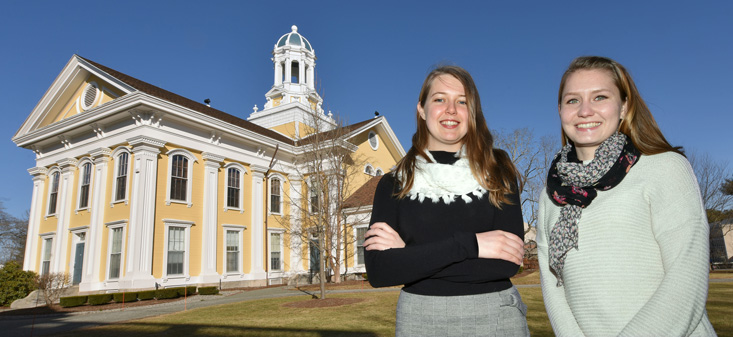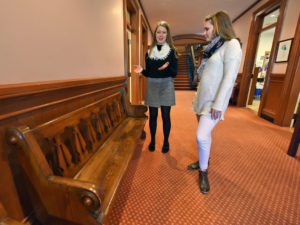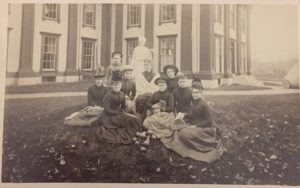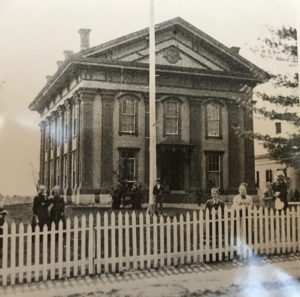Mary Lyon Hall history project

Student curators look beyond the facade
Mary Lyon Hall.
Big. Yellow. Iconic.
Everyone who has gone through Wheaton is familiar with this building that sits at the entryway to the campus. But how much do they really know about its past?
Soon the answer will be plenty, thanks to Emma Wynne ’18 and Anne Tucker ’20. They are curating an exhibition that will bring to life the history of Mary Lyon Hall with images and artifacts. There also will be a wall honoring and celebrating the alumni and staff who have won awards from the Alumni Board of Directors.
Visitors will be able to get a first look during Reunion Weekend, May 18 through 20.
Alumni Relations Director Courtney Shurtleff initiated the Mary Lyon history project last summer. She has been collaborating with Wynne and Tucker and their work-study supervisors, Assistant Professor of Museum Studies Leah Niederstadt and College Historian Zephorene Stickney-Helmreich, as well as Kate Boylan ’04, director of archives and digital initiatives, and Mark Armstrong, archivist and records manager.
“Mary Lyon Hall is used as a welcome location during Reunion Weekend and is also the first stop for many prospective students. We wanted to show them a snapshot of our history and showcase the evolution of the building,” Shurtleff said. “To many alumni walking through the doors, this is like coming home again. What I’m most excited about is watching alumni and guests’ reactions to the images and hearing what they remember about the building.”
Wynne and Tucker have spent months conducting research, combing through archival documents and images, and planning the display that will be on the first floor.
“We’re focusing on the uses of Mary Lyon Hall over the years and how the space has changed to accommodate that. There will also be information about Mary Lyon herself and why the building is named after her,” said Wynne, who is double majoring in art history and German studies.
The Greek Revival-style building was constructed in 1849. Formerly known as New Seminary Hall, it was renamed in 1910 for Mary Lyon, a pioneer in American education who was a consultant to the Wheaton family at the founding of the seminary and established the curriculum. It has served many uses over the years, including as a library, science lab, art studio, classroom, event space and gym.

“Emma and I came in to take measurements and we didn’t know yet that the benches were the originals. And we were standing on them. We were a little bit horrified when we found out,” said Tucker, who laughed about it with Wynne as they sat on a sofa in the May Room during a recent interview.
“Students interact with these things all the time or may have classes in Mary Lyon, but not realize how old the building is or how old these objects are, so it will be really great to show people,” Wynne said.
Not only is the project allowing the two students to uncover interesting information to share (for example, sharks were once dissected in Mary Lyon Hall, and Hebe, both a statue and a fountain, was once located just outside of the building), the work also is reinforcing what they have learned in the classroom, enriching their educational experience and allowing them to apply their knowledge. 
Tucker, who is majoring in art history with a minor in digital humanities, was already interested in the history of Wheaton as a work-study student in the archives. But the Mary Lyon project has sparked a passion that may lead her to a career in archival research.
“That’s not something that I had really ever considered before,” she said. “We’ve gotten to do a lot of research that, I think, opened up the idea that this might be something that I might want to go into.”
Both students said they have learned a lot about collaborating with a large team of people and have gained important professional skills.
“I’m only a sophomore and by the end of this year, there will be something at this school in a very important building that I helped create,” Tucker said. “And that’s a really incredible opportunity.”
And one that requires talented students to successfully pull off, said Niederstadt, noting, “They’re both incredibly competent, very intelligent young women.”
Find out more about Mary Lyon Hall on the new college history page.

